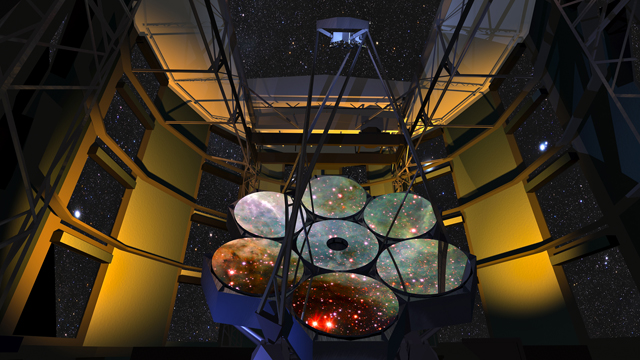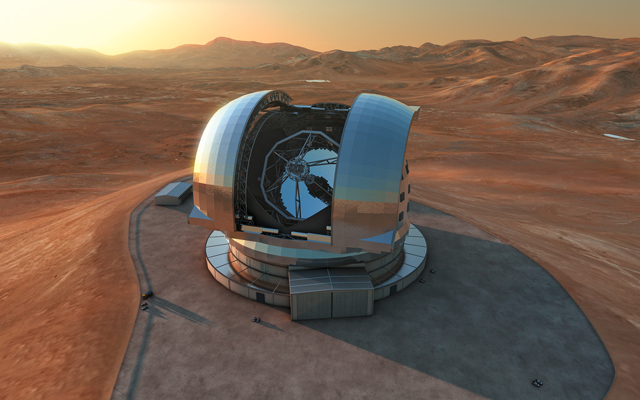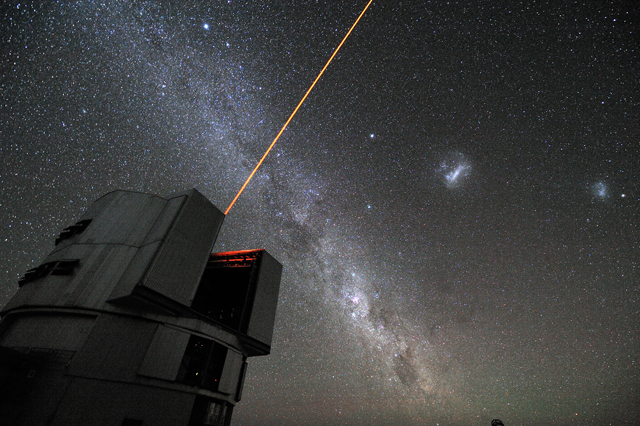Looking into the early Universe
Upon completion of the construction of three giant telescopes, they can completely change the modern astrophysics

Computer image of the " Giant Magellan Telescope ", one of three "extremely large telescopes", the construction of which is expected over the next 10 years. They will be large enough to consider the first objects of the Universe.
The oldest and most carefully kept secrets of the Universe, from dark matter to the shape of the Universe immediately after the Big Bang, can be revealed soon - after all, three “extremely large telescopes” are under construction, the scope of each of which exceeds the size of the basketball court.
Scientists hope that these telescopes, which are expected to be completed in the next ten years, will help them see the early Universe, moving from a uniform, hot and opaque state to a cold and structured one, in which matter begins to concentrate inside objects, and releases the light, sending it to travel through space.
“We are talking about a period from 100 million to 500 million years after the beginning of the universe; at that time, the first stars, chemical elements, black holes, and other exotic things first appeared, ”says an astronomer from the University of Cambridge, Gerry Gilmore.
')
Huge telescopes will look back in time, on the very first light emitted by objects. Soon after the Big Bang, the Universe swelled like the surface of a ball, and some places moved away from us so much that their first light flashes were coming just now. If you look at this light, you will be able to find out the structure and chemical composition of the first objects of the Universe, which are hinted at by vague photographs taken by the space telescope. Hubble, formed much earlier than predicted by the theory. Improving observations can lead to the emergence of new theories of the birth and evolution of the universe, says Gilmore.

Computer image of the “European Extremely Large Telescope” in the Atacama Desert, Chile. The 39.3-meter E-ELT will be the largest of the next three telescopes.
New telescopes with a cost of $ 900 million to $ 1.6 billion each, the giant Magellan telescope (HMT), thirty-meter telescope (TMT) and the European Extremely Large Telescope (E-ELT) - the diameters of the segmented mirrors of which reach 24.5 m, 30 m and 39.3 m, respectively - modern telescopes will significantly exceed (the diameter of the largest of the existing telescopes is 10.4 m). Their power will exceed the modern 5 - 200 times, depending on the telescope and the task.
Universities, government agencies and other scientific organizations around the world are funding their chosen projects in exchange for the possibility of using the telescope in the future, explains Patrick McCarthy, an astronomer at the Carnegie Institute observatories in California and director of GMT. And possession of a fraction of the time of use will have a good effect on the reputation of the institution in the future, as astronomers say, not related to these projects. “If you don’t have such an opportunity, you’ll have to invent something of your own to keep up with the competition,” McCarthy said.
Three projects continue to look for investors, and gradually approach the early stages of construction. GMT engineers leveled the surface on a mountain in Chile, finished casting four out of seven mirrors. The TMT and E-ELT projects (which will be built in Hawaii and Chile, respectively) make test mirrors. All three groups began developing tools.
Similar construction schedules should lead to competitions, but still, although each telescope boasts unique characteristics, it’s not about who gets involved first. “There is room for a lot of discoveries around us, so if you are three years late, it will not mean that you have lost a billion bucks,” said David Silva, director of the National Optical Astronomical Observatory in Tucson, Arizona. It is funded by the National Science Foundation, leading negotiations with TMT on possible cooperation.

An image of the HR8799 planetary system with a star and four planets, located 129 light-years away from us, taken by the Keck Observatory in Hawaii.
Telescopes will be powerful enough to personally observe the turmoil and hustle of other worlds. “We just touched a field of science like the study of exoplanets, and it will flourish with the advent of these telescopes,” says Roger Angel, an astronomer at the University of Arizona, who oversees the manufacture of mirrors for GMT.
Telescopes will track changes in the spectrum related to seasonal changes - and hence the active atmosphere - of the planets, following in orbits around other stars. They can even ferret out chemical signs of extraterrestrial life. “We expect the biochemical signs of extraterrestrial life to be fairly universal,” says McCarthy. Then, as the Curiosity rover searches for such signs, delving into the Martian ground, "we will do the same for extrasolar planets, but remotely, using spectroscopy," he explains.
The ability to observe the formation of a galaxy and how matter accumulates in space will help reveal the properties of dark matter particles — an invisible substance that makes up 84% of all matter in the Universe.
Observing the most extreme places in the universe — the edges of supermassive black holes — scientists plan to test the laws of general relativity and quantum mechanics with unprecedented accuracy. “We will look for radiation emitted during the annihilation of stars in the process of absorption by a black hole,” said Gilmore. “The way photons will go, with constant intervals or in groups, will tell us about the structure of space-time around black holes.” Previously, such observations were not possible, "because you need to very clearly consider the black hole, and for this to have an extremely large resolution."

Modern telescopes can boast of laser adaptive optics, eliminating image blur due to the atmosphere
Plans for future telescopes are based on a technology called "adaptive optics", which removes the distortions that light undergoes in the turbulence of the earth's atmosphere. “You use a laser to draw an artificial star in the sky, and then use them as the basis for determining turbulence on the telescope's line of sight,” Silva explains. Turbulence measurements dozens of times per second are used to move thousands of actuators connected to flexible mirrors in a telescope, changing their shape and negating atmospheric distortion. Adaptive optics are already used in small observatories, including 10-meter Keck telescopes in Hawaii. The task of adapting such a technology for telescopes is 2-4 times larger in diameter, “is at the forefront of real-time computing,” said Silva.
If the technology works as it should, GMT, TMT and E-ELT will distinguish between optical and near-infrared light - the most frequent types of electromagnetic radiation from the Universe - as if they were put into orbit. The James Webb space telescope , which is scheduled to go into orbit in 2018 with a five-year mission worth $ 8 billion, will complement the work of these observatories, possessing greater sensitivity in the middle and far infrared regions. But space telescopes are usually smaller, more expensive and less live.
“It will not be surprising that the productive scientific time of these telescopes will be 50 years,” said Silva.
And during this time, three telescopes can change the field of astronomy, physics and cosmology. In addition to the planned experiments, scientists hope to see some unexpected surprises shifting paradigms - just like in the past generation, 4-meter telescopes discovered that a mysterious substance called dark energy dominates in the Universe. After the launch of the new telescopes, says McCarthy, "for a while we will just look attentively at a certain empty part of the sky, and see what no one has previously seen."
Source: https://habr.com/ru/post/401221/
All Articles